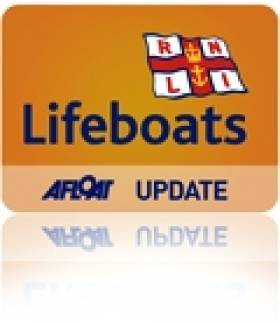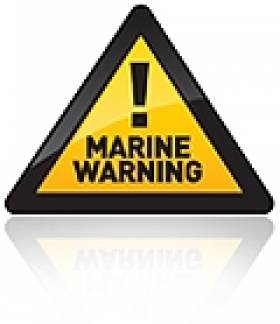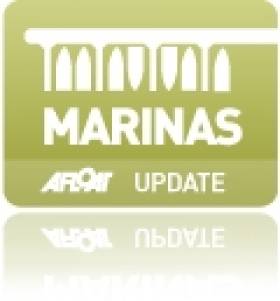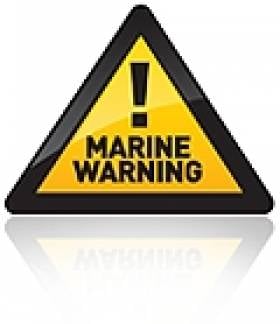Displaying items by tag: Mayo
#CoastalNotes - The Environmental Protection Agency (EPA) insists there was "nothing underhand" about its amendments to a 2007 licence for Shell's gas terminal at Bellanaboy in Co Mayo.
The Irish Times has a report on Tuesday's opening remarks of a three-day action at the Commercial Court, where it was alleged that the EPA intended to amend an earlier licence for the facility despite a more recent one being quashed by the High Court over environmental concerns.
As previously reported on Afloat.ie, local man Martin Harrington had claimed the EPA failed to carry out a proper Environmental Impact Assessment of the north-west Mayo region to meet EU requirements.
The outcome of that case last October was hailed as a victory for the long-time campaign against the controversial Corrib Gas Project.
Harrington's latest action is a judicial review challenge aimed at quashing the amendments to the 2007 licence. The Irish Times has more on the story HERE.
New Lease Of Life In Mayo For Unusual Arctic Visitor
#ArcticBuoy - An extraordinary visitor to Ireland's shores will be the subject of a new exhibition in Belmullet, Co Mayo next week.
As The Irish Times reports, Fergus Sweeney was on the shoreline at Blacksod in north Mayo last autumn when he spotted an unusual buoy floating in the water.
It turned out to be attached to an ice-tethered profiler, or ITP, that had been deployed three years before by American researchers on an ice floe in the Arctic Ocean - some 15,000 miles away.
The device was one of 60 deployed in an network measuring climate change, some of which have been lost, but none had been previously discovered further south than the Outer Hebrides.
But while its working life ended in 2012 thanks to water damage, the device will have a new lease of life thanks to Sweeney and a grow of local Transition Year students who have put together an exhibition tracing the buoy's voyage across the oceans.
The Irish Times has more on the story HERE.
Achill Island Lifeboat Attends Injured Woman Off Mayo Cliffs
#RNLI - Achill Island RNLI was tasked to assist a young woman in distress off the cliffs of Old Head in Louisburgh, Co Mayo yesterday afternoon (28 August).
The volunteer lifeboat crew sped to the scene around 4pm yesterday after the woman, who had been diving from a cliff into the sea, was injured on entering the water and required urgent assistance.
As the lifeboat was en route, some of the woman’s friends managed to pull her from the water onto nearby rocks, below the cliff, to await help.
The lifeboat arrived shortly after and sent two crewmen ashore to administer first aid. Westport Coast Guard Unit and Rescue 115, the helicopter from Shannon, were also tasked to the scene.
The woman was taken on board the lifeboat and transferred to the helicopter, which took her to Castlebar General Hospital where her injuries were treated.
Lifeboat operations manager Tom Honeyman said: “This had been a very busy but fulfilling year for the volunteer lifeboat crew with this, the 20th shout so far in 2013.
"It is also another good example of the different wings of the emergency services working in tandem to affect a successful outcome.”
Achill Island Lifeboat Assists Four In Two Sunday Launches
#RNLI - Achill Island RNLI responded to two separate incidents off the Mayo coast last Sunday 14 July.
The volunteer lifeboat crew was first requested to launch in the early hours of Sunday morning and again in the evening of the same day.
The crew on board the station’s all-weather lifeboat responded to a call-out a few minutes into Sunday morning when a red flare was reported to Malin Head Coast Guard Radio Station.
The flare was believed to have been seen on the Westport side of Clew Bay. The lifeboat searched the area but nothing was found and the crew returned to station at 3am.
The second incident happened at around 7.30pm when a cruiser with four people on board reported to Malin Head Coast Guard that it had engine problems and was disabled.
This was in the vicinity of Old Head on the south side of Clew Bay, and the Achill lifeboat was requested to assist the vessel.
af The casualty vessel was towed to Old Head Pier by another boat that was close by, and the lifeboat ensured that all were safe before returning to station.
RNLI Lifeboats Have Busy June Bank Holiday Weekend
#RNLI - It was a busy June bank holiday weekend around the country for RNLI lifeboats in West Cork, Mayo and the Midlands.
On Sunday afternoon, Baltimore RNLI assisted four people after their yacht got into difficulty a mile south of Mizen Head.
The 32ft yacht with four people on board had been propped by a pot buoy immobilising her in the water. The alarm was raised at 10.41am and lifeboat the Alan Massey was launched minutes later.
A local RIB, which had commenced towing, passed the tow to the lifeboat and the yacht was then taken to the safety of Crookhaven Pier.
This was the second call out this week for Baltimore RNLI. On Thursday last three men were rescued when their punt overturned near Horse Island.
Later on Sunday, Achill Island RNLI in Co Mayo brought a distressed fishing vessel with seven people on board to safety.
The volunteer lifeboat crew was requested to launch at 4.50pm to assist a small fishing vessel in the vicinity of Clew Bay and close to Clare Island. The vessel had encountered engine problems and was unable to return to port.
The boat and its crew of seven were subsequently towed safely to Curraun harbour by the Achill Island RNLI lifeboat.
Speaking after, Achill Island RNLI lifeboat operations manager Tom Honeyman said: "The presence of thick fog surrounding the vessel meant that great care was needed in the rescue and the fishing party of the vessel were delighted to return empty handed for a change."
Meanwhile in the Midlands, Lough Ree RNLI brought five people to safety in two call-outs over the weekend.
On Friday 31 May the volunteer crew was requested to launch around 5pm following a report that a cruiser had ran aground north of Quaker Island.
A local fisherman raised the alarm after spotting the cruiser on the rocks at the island located in the north end of Lough Ree raised the alarm.
The lifeboat crew managed to establish contact with the person on board the cruiser via mobile phone and he had confirmed that he had got lost and had ran aground. He reported that there was no water entering his boat. He was on his own but not injured.
The inshore lifeboat was launched and the crew was on scene at 5.30pm. It took the lifeboat 10 minutes to safely navigate its way through the rocky area to reach the casualty. The person on board the cruiser was taken to shore and arrangements were made for a specialist company to attend the scene to recover the cruiser.
Lough Ree RNLI was then launched on Sunday evening to assist a 26ft cruiser which had ran aground east of Green Island after sustaining engine failure.
The small cruiser with a family of four on board had lost engine power and had ran aground on the south east side of Lough Ree.
A crew launched the lifeboat at 8.40pm and arrived on scene 10 minutes later. After one of the lifeboat crew had carried out an assessment of the causality vessel, the decision was made to make an attempt to pull the vessel from the rocks, which the lifeboat was successfully able to complete.
Once the lifeboat had the vessel in deep water, a tow was set up and the casualty vessel was taken to Quigleys Marina in Athlone.
It marked the continuation of a dramatic week for the Lough Ree crew, after six were rescued from a sinking cruiser on the lough last Tuesday 28 May.
'Unusual' Dolphin, Whale Strandings In Northwest
#MarineWildlife - Seven dolphins and two beaked whales have stranded on beaches in the northwest in events described as "unusual" by the Irish Whale and Dolphin Group (IWDG).
On the Mullet Peninsula, a group of seven common dolphins - comprising five adults and two juveniles - live stranded at Tarmon Beach on Sunday 12 May.
Though initial attempts to refloat them were successful, one of the juveniles was later found dead and the other was euthanised due to poor health.
Meanwhile in Donegal, the fresh carcass of a female True's or Sowerby's beaked whale was found on Sunday evening on Five Fingers Stand at Inishowen - some days after a reported live stranding of a Sowerby's beaked whale on the Welsh coast.
The Inishowen stranding was followed yesterday 14 May by the discovery of a dead beaked whale calf at Trawbreaga Bay, in what is believed to be a connected stranding.
Samples of the adult female were taken in order to confirm the species, either of which would mark a rare cetacean record for Ireland - the first since 2009.
#MarineNotice - The latest Marine Notice from the Department of Transport, Tourism and Sport (DTTAS) advises that umbilical installation and associated works between the Corrib Gas Field and the mainland and Broad Haven Bay in Co Mayo will commence tomorrow 8 May.
The area of activity stretches along the route of the existing Corrib pipeline, and will continue till the umbilical pull-in to Glengad and subsequent lay away of the umbilical next month, followed by further tie-in works in the Corrib field to be completed by mid-July, weather permitting.
A number of work and service vessels will be used throughout the offshore works period, with various tasks from installing the main umbilical to post-lay jetting.
In order to create a safe working environment for the near-shore diving activities and the umbilical pull-in, a Safety Zone around the bellmouth (250m radius) will be identified with red marker buoys spaced at 75m interval around the circumference of the zone.
All vessels in the vicinity are requested to keep clear of the works as these works progress along the pipeline route and to comply with requests from support vessels and safety boats.
Furthermore, all vessels are requested to monitor and comply with the Radio Navigational Warnings that will be broadcast for the duration of the works. All vessels involved in the operations will be listening on VHF Channel 16 throughout the project.
Full details of co-ordinates of the work area and the work vessels involved are included in Marine Notice No 20 of 2013, a PDF of which is available to read or download HERE.
Rosmoney Quay Marina. Yacht & Boat Berths & Storage in Mayo
This important new potoon facility on Clew Bay is located approximately 30 metres from the edge of the permanent pier will allow users of the pier to board and disembark from their boats in a convenient and safe manner.
Mayo Sailing Club, islanders, boatmen and County officials gathered at Rosmoney Pier for the opening for public use of the new floating Pontoon at Rosmoney in April 2013.
Rosmoney near Westport is the base for the Mayo Sailing Club whose members enjoy the excellent sailing grounds that exists among the archipelago of islands in the east of Clew Bay.
Rosmoney is located 8km from Westport town and adjoins Clew Bay. Rosmoney Bay is currently the centre of access to Clew Bay for a wide number of users. Currently there are over 100 marine craft of various descriptions moored in Rosmoney.
The pontoon is made up of a floating pontoon and ramp with safety railings, a water source and power facilities which makes it possible for boats to moor at Rosmoney including local fish farm vessels. Islanders will be allowed to tie their boats to the pontoon while on business on the mainland while other boat users are to use it for loading and uploading.
#MarineNotice - Marine Notice No 15 of 2013 from the Department of Transport, Tourism and Sport (DTTAS) advises mariners that a hydrographic and geophysical survey operation is being undertaken by INFOMAR for the Sustainable Energy Authority of Ireland till 25 April.
The RV Celtic Voyager (Call sign EIQN) is carrying out the survey operations within an area bounded by co-ordinates included in the notice, available as a PDF to read or download HERE.
The vessel is towing a magnetometer sensor with a single cable of up to 100m in length. It is also displaying appropriate lights and markers, and will listen in on VHF Channel 16 throughout the project.
Meanwhile, Marine Notice No 16 of 2013 advises that Shell E&P Ireland is deploying a Waverider buoy off northwest Co Mayo to help predict sea conditions for the laying of an offshore umbilical to the Corrib Gas Field later this year.
The buoy is yellow in colour and will flash yellow five times every 20 seconds. The notice includes an image of what the buoy looks like in the water, as well as the co-ordinates of its placement.
All vessels are requested to give the wave buoy a wide berth.
Nighttime Navigation Issues Led to Grounding of 'Pirate Queen' - MCIB
#MCIB - "Serious weaknesses" in navigational procedures and practices led to the grounding of a passenger boat at Roonagh Pier in Co Mayo last winter, according to the official report into the incident.
The inter-island passenger ferry Pirate Queen - operated by Clare Island Ferry and Clew Bay Cruises Ltd - grounded on rocks at the entrance to Roonagh Pier on the evening of 20 December 2011 as it made a nighttime approach to the pier.
Two crew were joined by three passengers on board at the time, one of whom served as auxiliary crew while another was injured when the vessel was jolted in heavy swell. The vessel itself, though not holed, sustained severe structural damage.
It emerged that the navigational aid lights on the pier - maintained my Mayo County Council - were not fully functioning at the time of the incident and did not illuminate the waters in the vicinity of the pier, making any approach in darkness a dangerous one, particularly at a location where swells were common at the best of times.
However, the Pirate Queen continued on its heading to Roonagh Pier despite its master being made aware of the lighting issue via SMS shortly after leaving Inishturk.
On approach is was noted that the search light was not manned, and when the lookout reported that the vessel was too far to the east, a large swell forced the boat onto rocks on the east side of the pier.
Lifejackets were immediately put on the passengers, while a fellow ferry master returning home on his RIB was hailed to quickly retrieve the passengers from the boat.
As the ferry was rolling and grinding on the rocks in the heavy swell, one of the passengers was thrown against a bulkhead or the hull and suffered a back injury, though luckily avoided head injury due to the lifejacket. All three passengers were transferred ashore safely via RIB.
In its findings, the Marine Casualty Investigation Board (MCIB) initially focused on the pier lighting, both high-level and navigation lights, noting their vulnerability to storm damage and the lack of effective screening.
But upon further analysis, the report highlighted a number of deficiencies in the running of the ferry service itself, such as the lack of crew rosters to ensure a full complement for any sailing, and the absence of an alternative plan in the event of difficulties landing at Roonagh Pier.
In addition, it noted "an over-reliance of visual aids to navigation and a neglect to practice and use the electronic aids on board.
"When one is very familiar with the waters and on regular passages it is very easy to become complacent," the report stated.
It also noted the "hazardous and unacceptable" decision following the incident to move the boat from Roonagh Pier to Clare Island without informing the Irish Coast Guard of the situation.
The MCIB recommends that the ferry operators devise specific approach instructions, ensure that all employees take part "in the full range of emergency procedures" and that crew rosters be drawn up and displayed. The complete report is available to download below.







































































